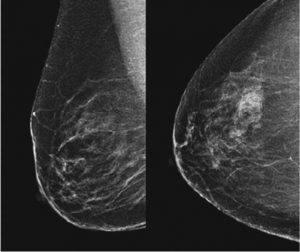By Sharla Gayle Patterson, MD, MBA
Learning a new language can take time and effort. Even learning how language started is controversial. From historical drawings to recordings of sign language, humans have communicated in various ways. We have embraced technology in all aspects of our life, including healthcare. The electronic medical record allows us to read the reports as the doctors write them. But this is like learning a new language for many.
 Let’s learn the language of mammograms. Mammograms are x-rays used to detect breast cancer. Often, a mammogram can find breast cancer before any signs and symptoms. There are many findings in a mammogram report that can be confusing.
Let’s learn the language of mammograms. Mammograms are x-rays used to detect breast cancer. Often, a mammogram can find breast cancer before any signs and symptoms. There are many findings in a mammogram report that can be confusing.
A mammogram’s “impression,” or final reading, will be scored from 0 to 6. Before this number, you will see BI-RADS®. But what is BI-RADS®? BI-RADS® stands for breast imaging reporting and data system. The system is used worldwide and allows Dr. to communicate with one another about their findings. The scores 0 to 6 enable doctors to share what the chance of finding cancer in that mammogram or ultrasound might be. A BI-RADS® 0 means that the mammogram is incomplete. The most common reason for seeing this is that the place doing your mammogram needs your old films or needs to bring you back to do more imaging. BI-RADS® 1 or 2 are the scores you receive when your mammogram is normal, and there is no sign of cancer. Skipping to the end of the line, BI-RADS® 6 is the score you only see if you have been diagnosed with breast cancer. BI-RADS 4 or 5 means that there is a suspicious abnormality for which a biopsy is recommended.
The category in between, BI-RADS® 3, causes the most concern. When you read this, you will see the word ‘probably benign,’ which is not a subjective call made by the radiologist where they are just guessing and think it is probably OK. This is a statistical measurement that what they see on your mammogram is less than a 2% chance of being cancer. Based on this score, the recommendation is to have a mammogram or ultrasound before the usual 12-month period. The scores 0 to 6 have strict definitions that radiologists and clinicians are trained to understand. National regulatory agencies set the words that accompany those scores. Here, in the United States, a BI-RADS® 3 will automatically have the words probably benign following them. This is meant to ease fear and allow patients to understand what a BI-RADS®3 means. However, this “probably” word in the reading does create anxiety.
Another language that you’re reading on your mammogram report is your density score. In the 1990s, States began requiring that mammogram reports list the density of a woman’s breast. Density is simply a measurement of the glandular or active breast tissue as it relates to how much of the breast tissue is adipose or fatty. As you age, the breast tissue becomes fattier and less functioning. We all see this as we age and our bra requirements change. The measurement of density is required to be reported on your mammogram. The most common density score is heterogeneously dense. Heterogeneous means that 51 to 75% of your breast volume is still glandular tissue, with the rest being adipose or fatty tissue. There are three other categories, including scattered, extreme, and adipose. Since all mammograms are required to report your density, you will see some suggestions for women with dense breasts. It is very common to have dense breasts. Women with dense breasts may benefit from additional screenings like an MRI or an ultrasound. However, sometimes insurance does not cover this. It is very important to discuss this with your healthcare provider. Despite having dense breast tissue, a common finding, a mammogram is still recommended for screening.
As we embrace technology and learn how to read our medical records, it is essential to understand that the final disposition and decisions about your health care should be made closely with your doctor. It is hazardous and very anxiety-provoking to read your medical reports, including your mammogram, and try to make decisions about your own healthcare needs and plans. More access to information means that you’re going to have to have more communication with your doctor. Some people find it better to wait to read their medical reports until they’ve had a chance to review them with their doctor. This is a very reasonable approach and will minimize many sleepless hours and Internet searching, which may not be appropriate.
Sharla Gayle Patterson, MD, MBA
Board Certified Breast Surgical Oncologist
Sharla Gayle Patterson is a fellowship trained breast surgeon certified by the American Board of Surgery. She is the only surgeon in South West Florida certified by the American Society of Breast Surgeons in both ultrasound and stereotactic guided breast biopsies. For more than a decade, she has worked diligently to educate the world around her about what can be done to decrease a person’s risk for breast cancer. Magnolia Breast Center serves as the first comprehensive breast health program in Southwest Florida. Her dedication to providing the highest level of surgical care is manifest in her successful certification in oncoplastic breast surgery by the worldwide known School of Oncoplastic Surgery. Her passion does not end with surgery, as many of her patients will attest – she continues to address the importance of survivorship and has built the area’s first and only multidisciplinary breast cancer survivorship clinic.
At home, Dr. Patterson enjoys spending time with her husband and three daughters. Glitter, glue, and grit make up her secret recipe for family harmony.
MAGNOLIA BREAST CENTER
3530 Kraft Rd, Suite 202, Naples, FL 34105
239.758.PINK (7465)
magnoliabc.com








